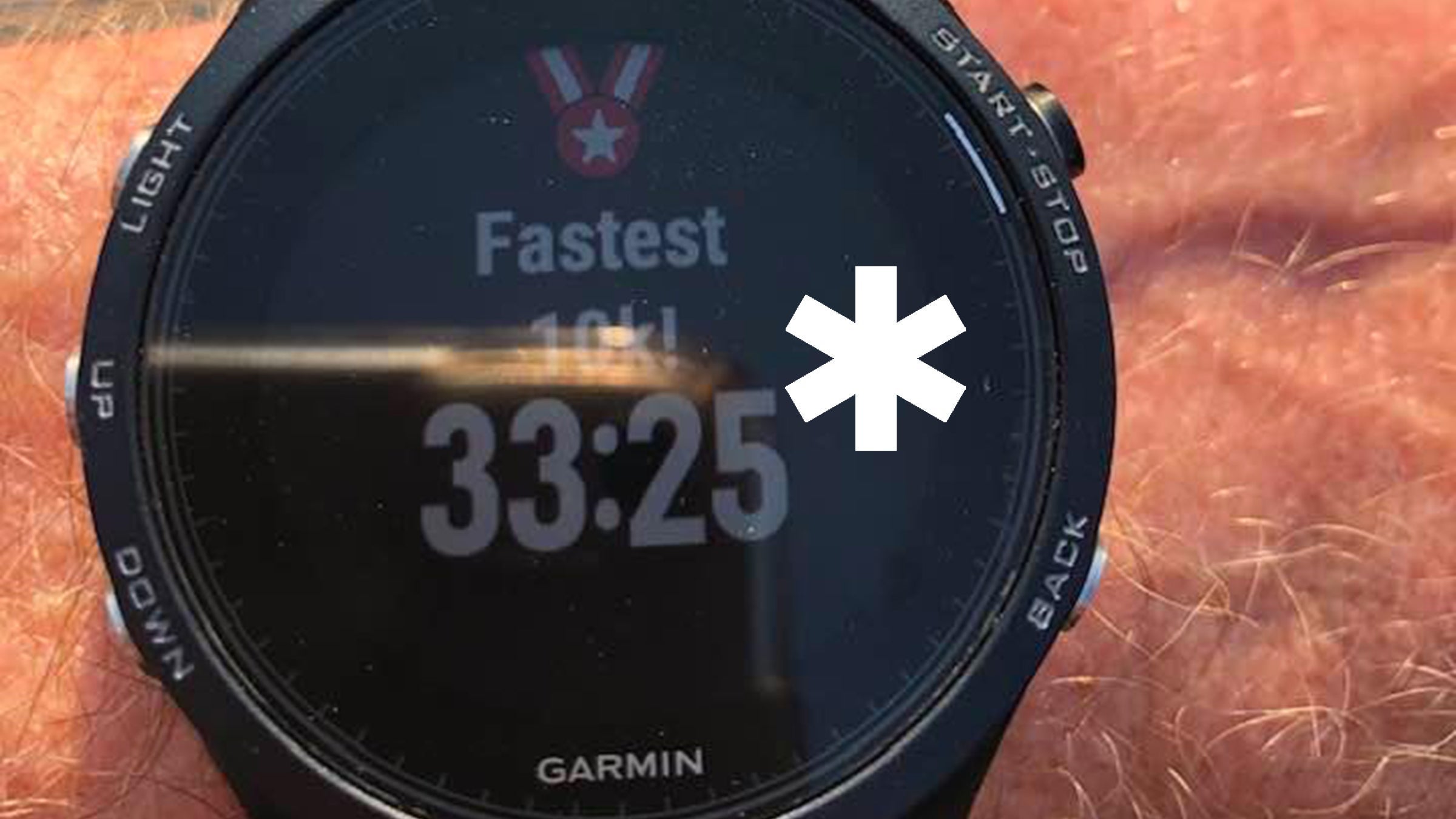Last Saturday, Matt Fitzgerald, author and frequent PodiumRunner contributor, ran a lifetime best in the 10K. He clocked 33:25, a 9 second improvement over his previous best of 33:34. He was, of course, stoked — particularly as he is 49.
Tricky thing is, the 33:34 was run in a real race, the 2007 Davis Turkey Trot, where the course was certified, the timing digital, other runners were on the course, and the results were published. This time, it was run alone, in a time trial, measured by GPS, with results only on Matt’s watch.
What should he consider his PR? 33:34 or 33:25?
Later that day, Matt put the question to his Facebook friends: “Before COVID I would never have considered counting a GPS-measured time-trial result as a PR. Now I’m not so sure. What do you say: PR or not?”
133 people responded, the vast majority saying some version of “Heck yea.” But the naysayers were adamant about why it doesn’t count, and several suggested using a variety of different categories for our personal records.

It’s All About the Competition
The argument for not counting a time trial as a PR center around the additional challenges of an actual race. “As a competitive runner/ triathlete/coach for fifty years my answer is NO!!!,” said Scot Moser. “Great effort but there is so much more that goes into a race. Dealing with pre race, race delays, conditions, and most importantly the surges of adrenaline that happens in competition.”
Masters champion and PodiumRunner columnist Pete Magill chimed in similarly: “Sorry, great run! But no PR! A big part of the challenge of a PR is that you have to race on a designated day, at a designated time, regardless of environmental conditions, and deal with whomever else is in the race. I’ve always figured I was 1–2% better than my actual PR time, after factoring in all the above.”
“Nope, not a PR unless it’s a race; Too many things different in a race scenario,” said Laura Zimmitti, adding, “ It’s a little bit like Kipchoge’s sub-2hr Marathon.”
Come to think of it, it is a lot like Kipchoge’s sub-2 attempts, and the controversy over whether his performance meant anything. The phalanx of pacers aside, Kipchoge’s mark is not a world record because it wasn’t in a race setting. Those are the rules of international competition. But is 1:59:40 his PR?
Those who deny the legitimacy of a time-trial PR believe that a race is fundamentally a competition between two or more runners to see who can cover a set distance faster. The time is rather irrelevant; it serves only to compare the runners’ performance to others in other locations and times. Those other locations and times need to be as similar as possible, including being in a similar head-to-head competitive setting. The PR has no meaning except in relation to other PRs in that sport-specific setting.
This is how Matt ideally sees running too: “Running is more than a sport for me, but it is a sport first and foremost,” Matt wrote when I asked how he himself felt about the question. “My preference is to best other runners in competition in a way that leaves no room for denial on their part.”
Like the rest of us, however, Matt is having to deal with a world without such opportunities. “But that’s not possible right now,” he wrote. “Which frustrates me a little, but only a little because I get a lot of satisfaction out of proving what I can do to myself.”

Competing Against Time
Proving to ourselves what we can do, competing to be our best self, is what most of us in the pack do anyway. For most of us, no matter who is in the race with us, our competitor is time. We often don’t know or care what place we came in. A race isn’t primarily about running against others but a structured setting in which to officially register a mark — and those marks, our PRs, are how we measure our status as a runner.
With this view, time trials are a more acceptable means of competing, a legitimate way to measure our training and race efforts, to see progress, and maybe even improve our best ever performances.
Even if we value time over distance as the primary objective of competing, however, that structured race setting is important. Races, if they have any credibility, have accurately measured courses and timing systems. “Official results” tell us and the world that we actually ran that fast over that distance. Even if no one else knows or cares, knowing the validated legitimacy of the effort is essential for our own satisfaction.
Even though we’re doing the validating, we can have this legitimacy in a time trial too. Matt wrote, “I like to compete, and competition only works with structure and standards. Only earned success makes me feel successful.” In the case of his 10K time trial, he says he wheel-measured his loop course and it turned out to be slightly longer than what his GPS watch said. “So I decided to ditch the wheel and run by the watch,” he said. “I knew haters were gonna hate anyway, but I knew as well that if I posted a good time over a distance that was at least 10K and probably longer, I would feel satisfied with the result in a way that couldn’t be shaken by any amount of outside cynicism. And I do!”
In the end, however, he still hadn’t answered the question, so I put it to him again, “10 years from now, if this is as fast as you get in the 10K, will 33:25 be what you cite as your PR?”
“Probably,” he replied, “but I would contextualize it any chance I got.”
With an Asterisk
A few of the Facebook responses also reflected this idea of contextualizing our time-trial PRs. One suggested calling them BKT’s, for Best Known Time. Another suggested distinguishing between PRs (in a certified race) and PBs (best times), although that only works for Americans, as most other english speakers around the world use PB for what Americans call PRs.
The most succinct and perhaps most appropriate response was from Martin Walsh, who simple wrote, “*asterisk.”
The fact is, every PR, even every race result, has an asterisk. The asterisk could be the conditions (perfect temps, tailwind…), the course (Boston’s net downhill…), the field (a perfect pacing group who pulled you along…), the equipment (super shoes…) or even an anomaly in the course or timing.
Case in point, in asking Matt about what he’d say 10 years from now, I started thinking about what I consider my lifetime best performance: a 1:16:54 run at the 1996 Philadelphia Distance Run. It was a certified course and an accepted, major event, so I have no qualms claiming it as my PR.
But it does have an asterisk: Ask anyone who ran the PDR during that era, and they’ll tell you it was ridiculously fast. I used to say I had half marathon PRs and Philadelphia PRs, which were a minute or more faster; we’d joke that the streets of Philadelphia must have Mondo in them. Whenever I cite that time, I have to qualify it with, “but it was set at the Philadelphia Distance Run.”

Given that, I know that I once ran a better half, but I can’t claim it as my PR. In the 1998 Brooklyn Half Marathon, I clocked 1:17:26 on the old course that ran from Coney Island up to Prospect Park. But, while my average mile hovered around 5:50, my first mile was 6:42. Many of my friends’ first mile splits were off too. Doug Olney, the Prospect Park Treasurer and my training partner, measured the course after and found the first mile was actually 1.11 miles long. Corrected, I covered the 13.1094 miles of a half marathon in 1:16:47 that day. But the official results were never “corrected” so I don’t feel I can call it my PR.
The Point
That phrase, “I don’t feel” is key. No one else would know or care if I claimed a half marathon PR 7 seconds faster than my best official time. And no one can call you a liar if you claim a time-trial PR as your lifetime best. There are no governing body rules on PRs. It doesn’t matter what anyone else thinks anyway: If you know the effort was legit, if you feel it meets the criteria for fairplay, you can call it your personal record.
What matters more is that we find a venue in which to compete that we consider real and worthwhile. It’s all well and good to say you can only count results in “real races” but that leaves you with no chance to celebrate performances now, with no relief in sight. Matt says, about his satisfaction in proving things to himself even outside the context of real races: “I wouldn’t train as hard as I have been lately otherwise!”
What matters is striving for excellence. Matt is fast enough he could be winning races and setting masters course records. But, even for him, racing alone has meaning, because, he says, “The deeper satisfaction for me is the process of pursuing mastery. I love seeing what I can do if I test my experience and knowledge and passion and discipline to the absolute limit.”
We can do that alone with a watch just as well as we can in a marathon major. There are a lot of elements of racing we can’t duplicate, which we miss dearly, but setting PRs doesn’t have to be one of them.
Yes, our virtual, time-trial PRs will have asterisks, but, so what? PRs always do.


